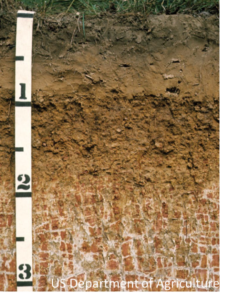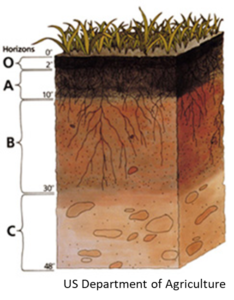Main Body
Chapter 15
Topic 15 – Dirt, Soil and Biospheric Interactions
In the lithosphere the thin layer of surface materials above bedrock but below the atmosphere are the accumulated products of weathering and erosion. On its own, solid rock that is broken down  into smaller rock particles through weathering is called sediment. When chemical or biological processes act on this sediment, modifying it in place, it develops into a soil. This can happen from the top down, for example, through the decay of leaf material that falls on the surface. It can also happen from the bottom up, as water moves minerals through the sediment, and supports chemical reactions and physical weathering. The original sediment is referred to as ‘parent material’ for the developing soil. A well-developed soil has undergone significant transformation from its original parent material and can support a variety of living organisms from bacteria and insects to plant life and burrowing animals. In fact the type of soil which develops in a region acts as a major control on the living systems both above and below the ground and for that reason soil plays a dominant role in the the critical zone.
into smaller rock particles through weathering is called sediment. When chemical or biological processes act on this sediment, modifying it in place, it develops into a soil. This can happen from the top down, for example, through the decay of leaf material that falls on the surface. It can also happen from the bottom up, as water moves minerals through the sediment, and supports chemical reactions and physical weathering. The original sediment is referred to as ‘parent material’ for the developing soil. A well-developed soil has undergone significant transformation from its original parent material and can support a variety of living organisms from bacteria and insects to plant life and burrowing animals. In fact the type of soil which develops in a region acts as a major control on the living systems both above and below the ground and for that reason soil plays a dominant role in the the critical zone.
Soils represent a unique part of the physical environment where the abiotic (non-living) and biotic (living) components of Earth Systems interact significantly. Biological material like dead plants and animal matter are broken down by bacteria and insects in the upper layer of the soil and minerals are contributed by soil parent material. Water and oxygen are moved through and stored within pore spaces between soil particles. This creates an opportunity for plants to access the nutrients they need to live and grow, supporting broader life at the surface of the Earth.
Here are a few key things to understand about why soils are so significant to Earth System function:
- Soils regulate water flow and nutrient delivery in the upper lithosphere
- Soils act as filters, buffers, and catalysts for chemical reactions
- Soils are significant storehouses for conserving and cycling nutrients like nitrogen, phosphorous, potassium and carbon
- Soils support the engineered structures we build on top of them, like houses, bridges and roads
Considering how important soils are to the critical zone and ecosystem function, it is important to remember that:
- How we manage the soil affects its quality
- A soil that develops in place is unique to that space, based on its physical, chemical, and biological properties
- Soil forms based on specific soil-forming factors including:
- o Parent material
- o Climate
- o Living organisms
- o Topography
- o Time
- Most soils form very slowly and have limits (which need to be understood for appropriate management)

- Soil erosion and degradation can happen very quickly if not managed properly
- The study of soils is a science of its own, known as ‘pedology’
The average soil is constructed of sediment particles like clay, silt and sand (~45%), organic material (~5%) and pore space between soil particles that may be filled with water or air (~50%). The dominant particle size plays a significant role in soil properties like drainage and root capacity.
A soil texture diagram visually demonstrates the different range of soil textures based on which of the three sediment sizes are most dominant in the mixture.
Soil scientists further characterize soils based on the layers they have developed over time. These layers are referred to as ‘soil horizons’ and contain specific indicators of soil maturity. The most common soil horizons and their defining characteristics are labelled here:
O horizon – decomposing organic material
A horizon – mixed mineral material and decomposed organics
B horizon – mineral material altered by soil forming processes
C horizon – base layer of weathering parent material
Soil horizons are recognized by there colour and other physical attributes, like how well they drain water, their clay content, the amount of organic material they contain, and many others.
In many ways, soils are the connecting point for the Critical Zone between the biotic and abiotic parts of Earth Systems. The many microorganisms in soil play a significant role in breaking down both mineral and organic materials, and they also produce and consume atmospheric gases. The vegetation that soil supports also interacts with the atmosphere and hydrosphere and plays a critical role as a food source in the biosphere, supporting larger life forms (including humans!). Yet, even soil can be linked back to the basic relationship we have with the Sun. Climate and soils are linked together because the type of vegetation that can grow in a specific climate affects the chemical balance of a soil. For example, the soils in a coniferous forest in northern Canada are very acidic, given the natural acidity of coniferous needles. Soils closer to the equator generally experience greater rates of evaporation from their surface and can have a buildup of salt, leading to more alkaline (basic) soil chemistry. Of course, there are also many other local factors that can affect the chemistry of a soil as well.
Remember, understanding Earth Systems is all about better understanding the linkages between the systems and how they interact to create something bigger than the sum of the parts. Soils play a significant role in this understanding and geoscientists that work on understanding soils better are a key part of our future shared success.
The short video below illustrates just one of the connections between broader Earth Systems and soils, focusing in on soils as a carbon storage system. Watch to see what happens if we misuse the soils we have:
